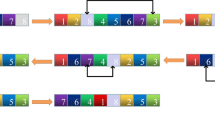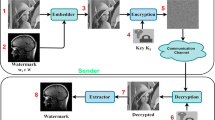Abstract
This paper proposes a reversible data hiding scheme with high capacity-distortion efficiency, which embeds data by expanding prediction-errors. Instead of using the MED predictor as did in other schemes, a predictor with context modeling, which refines prediction-errors through an error feedback mechanism, is adopted to work out prediction-errors. The context modeling can significantly sharpen the distribution of prediction-errors, and benefit the embedding capacity and the image quality. To expand prediction-errors, the proposed scheme utilizes a generalized expansion, which enables it to provide capacities larger than 1 bpp (bits per pixel) without resorting to multiple embedding. Besides, a novel boundary map is proposed to record overflow-potential pixels. The boundary map is much shorter compared with either a location map or an overflow map even though it is not compressed. The combination of the context modeling, the generalized expansion and the boundary map makes the overall scheme efficient in pursuing large embedding capacity and high image quality. Experimental results demonstrate that the proposed scheme provides competitive capacity compared with other state-of-the-art schemes when the image quality is kept at the same level.








Similar content being viewed by others
Notes
In this paper, we use overflow to represent both overflow and underflow as a simplification.
We are considering 8-bit grayscale images in this paper, i.e., pixel values are between 0 and 255.
References
Alattar AM (2004) Reversible watermark using the difference expansion of a generalized integer transform. IEEE Trans Image Process 3(8):1147–1156
Barton JM (1997) Method and apparatus for embedding authentication information within digital data. US patent 5 646 997
Chang CC, Lu TC (2006) A difference expansion oriented data hiding scheme for restoring the original host images. J Syst Softw 79(12):1754–1766
Chang Z, Kou W, Xu J (2007) More compressible location map for reversible watermarking using expansion embedding. Electron Lett 43:1353–1354
Chen M, Chen Z, Zeng X, Xiong Z (2009) Reversible data hiding using additive prediction-error expansion. In: ACM multimedia and security 09, pp 19–24. Princeton, NJ
Chen M, Chen Z, Zeng X, Xiong Z (2009) Reversible image watermarking based on full context prediction. In: ICIP 2009, pp 4253–4256. Cairo, Egypt
Chung KL, Huang YH, Yang WN, Hsu YC, Chen CH (2009) Capacity maximization for reversible data hiding based on dynamic programming approach. Appl Math Comput 208(1):284–292
Fridrich J, Goljan M, Du R (2002) Lossless data embedding—new paradigm in digital watermarking. EURASIP J Appl Signal Process 2002:185–196
Hsiao JY, Chan KF, Chang JM (2009) Block-based reversible data embedding. Signal Process 89:556–569
Hu Y, Lee HK, Li J (2009) DE-based reversible data hiding with improved overflow location map. IEEE Trans Circuits Syst Video Technol 19(2):250–260
Hwang J, Kim J, Choi J (2006) Reversible image watermarking based on histogram modification. In: IWDW 2006. LNCS, vol 4283, pp 348–361. Jeju Island, Korea
Jiang J, Guo B, Yang SY (2000) Revisiting the JPEG-LS prediction scheme. In: Vision, image and signal processing, pp 575–580
Kim HJ, Sachnev V, Shi YQ, Nam J, Choo HG (2008) A novel difference expansion transform for reversible data embedding. IEEE Trans Inf Forensic Secur 3(3):456–465
Kim KS, Lee MJ, Lee HK, Suh YH (2008) Histogram-based reversible data hiding technique using subsampling. In: ACM multimedia and security 08, pp 69–75. Oxford, UK
Kuribayashi M, Morii M, Tanaka H (2008) Reversible watermark with large capacity based on the prediction error expansion. IEICE Trans Fundam E91(7):1780–1790
Lee CC, Wu HC, Tsai CS, Chu YP (2008) Adaptive lossless steganographic scheme with centralized difference expansion. Pattern Recogn 41(6):2097–2106
Lin CC, Hsueh NL (2008) A lossless data hiding scheme based on three-pixel block differences. Pattern Recogn 41(4):1415–1425
Lin CC, Tai WL, Chang CC (2008) Multilevel reversible data hiding based on histogram modification of difference images. Pattern Recogn 41:3582–3591
Lin CC, Yang SP, Hsueh NL (2008) Lossless data hiding based on difference expansion without a location map. In: 2008 congress on image and signal processing, pp 8–12
Memon N, Wu X (1997) Recent developments in context-based predictive techniques for lossless image compression. Comput J 40(2):127–136
Ni Z, Shi YQ, Ansari N, Su W (2006) Reversible data hiding. IEEE Trans Circuits Syst Video Technol 16(3):354–362
Thodi DM, Rodriguez JJ (2004) Prediction-error based reversible watermarking. In: ICIP 2004, pp 1549–1552. Singapore
Thodi DM, Rodriguez JJ (2007) Expansion embedding techniques for reversible watermarking. IEEE Trans Image Process 16(3):721–730
Tian J (2003) Reversible data embedding using a difference expansion. IEEE Trans Circuits Syst Video Technol 13(8):890–896
Tsai P, Hu YC, Yeh HL (2009) Reversible image hiding scheme using predictive coding and histogram shifting. Signal Process 89:1129–1143
Tseng HW, Chang CC (2008) An extended difference expansion algorithm for reversible watermarking. Image Vis Comput 26(8):1148–1153
Vasiliy S, Kim HJ, Xiang S, Nam J (2008) An improved reversible difference expansion watermarking algorithm. In: IWDW 2007. LNCS, vol 5041, pp 254–263. Guangzhou, China
Weinberger MJ, Seroussi G, Sapiro G (2000) The LOCO-I lossless image compression algorithm: principles and standardization into JPEG-LS. IEEE Trans Image Process 9(8):1309–1324
Wu X, Memon N (1997) Context-based, adaptive, lossless image coding. IEEE Trans Commun 45(4):437–444
Acknowledgements
This work is supported by the Fundamental Research Funds for the Central Universities, and Development Program of China and Beihang University Graduate Innovation Fund. The authors would like to thank the anonymous reviewers for their valuable comments to improve the quality of the paper.
Author information
Authors and Affiliations
Corresponding author
Rights and permissions
About this article
Cite this article
Fan, W., Chen, Z., Chen, M. et al. Reversible data hiding with context modeling, generalized expansion and boundary map. Multimed Tools Appl 57, 477–499 (2012). https://doi.org/10.1007/s11042-010-0641-9
Published:
Issue Date:
DOI: https://doi.org/10.1007/s11042-010-0641-9




